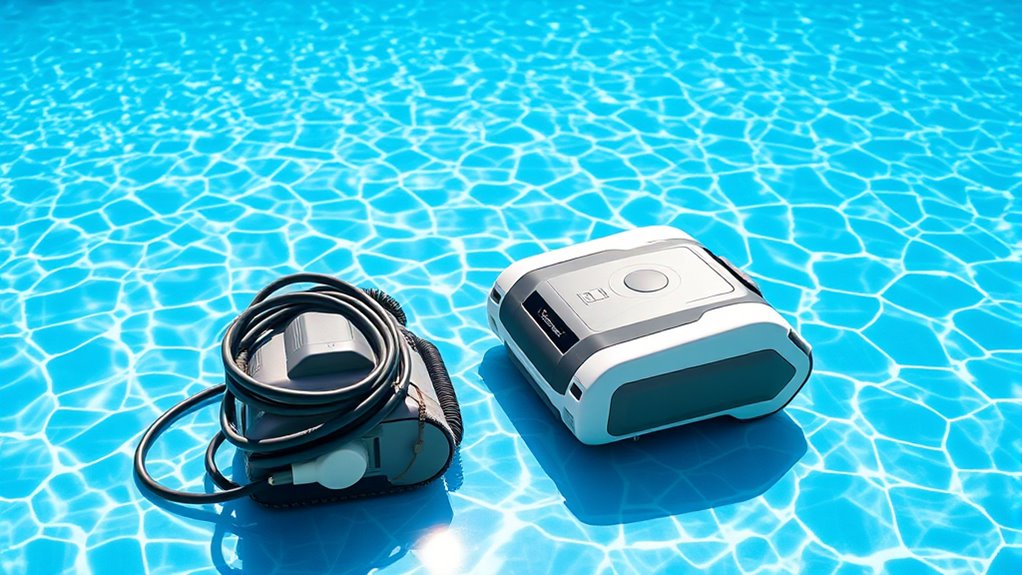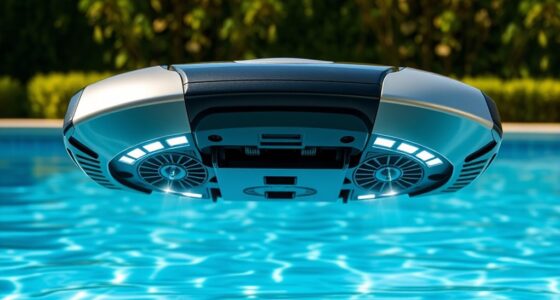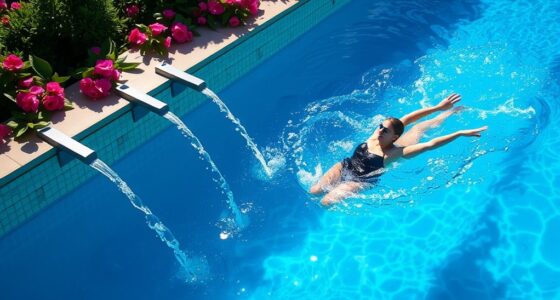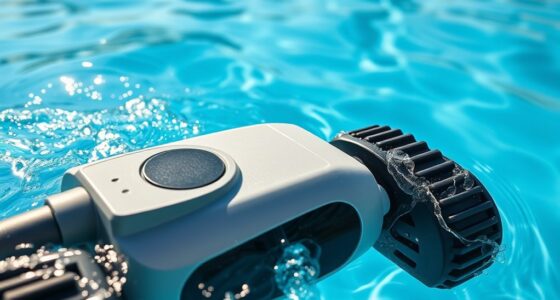Robotic pool cleaners are gradually replacing traditional suction models thanks to advances in technology, better efficiency, and convenience. While suction cleaners remain popular for their lower upfront costs, more homeowners are choosing robots for automated, thorough cleaning and smart features. As innovations like AI and eco-friendly options develop, robots are gaining ground. To discover how these trends impact you and what the future holds, explore further insights on this evolving market.
Key Takeaways
- Robotic pool cleaners are gaining popularity due to advanced navigation and automation features, offering more efficient and comprehensive cleaning.
- Traditional suction cleaners remain cost-effective and widespread, especially among budget-conscious homeowners, limiting rapid market shift.
- The higher upfront cost of robotic cleaners is a barrier, but long-term savings and convenience are driving increasing adoption.
- Market trends show a gradual shift toward smart, eco-friendly robotic devices, gradually overtaking suction cleaners in premium segments.
- Overall, robots are increasingly encroaching on the suction cleaner market, but traditional models still dominate due to affordability and familiarity.
Overview of Traditional Suction Pool Cleaners
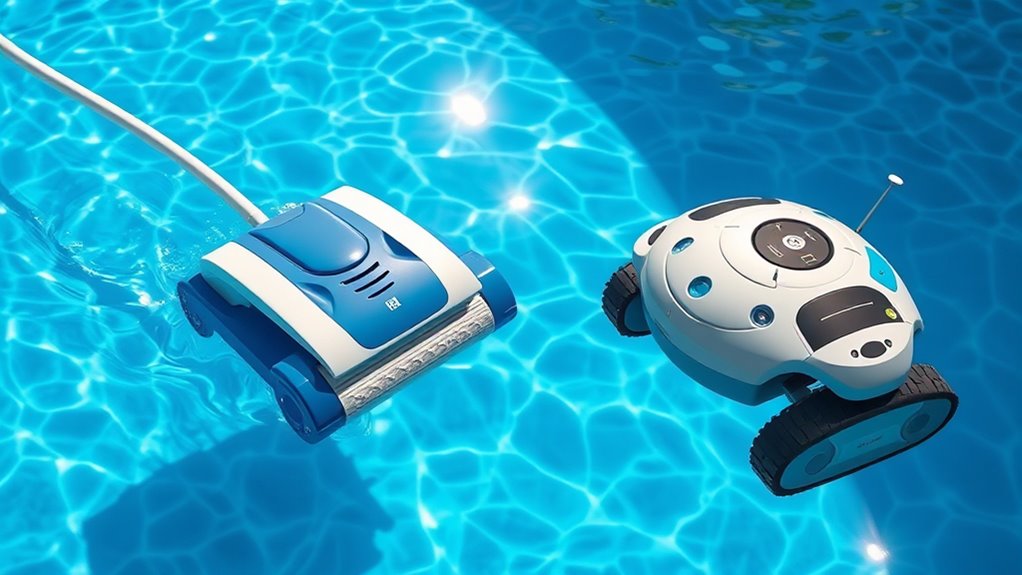
Have you ever wondered how traditional suction pool cleaners work? They operate by connecting to your pool’s skimmer or dedicated suction line, using the pump’s water filtration system to power their movement. As the pump runs, water flows through the cleaner, creating suction that pulls debris from the pool floor and walls. This debris is then trapped in the cleaner’s filter bag or canister. To keep your pool balanced, you need to monitor the pool chemical levels, ensuring the water stays clear and safe. These cleaners are effective at covering large areas and removing dirt, but they rely on your pool’s filtration system and don’t require batteries or external power sources. Their simplicity makes them a popular choice for many pool owners. Additionally, understanding the importance of contrast ratio can help in selecting the right equipment for enhanced visibility and performance in various lighting conditions.
Rise of Robotic Pool Cleaning Devices
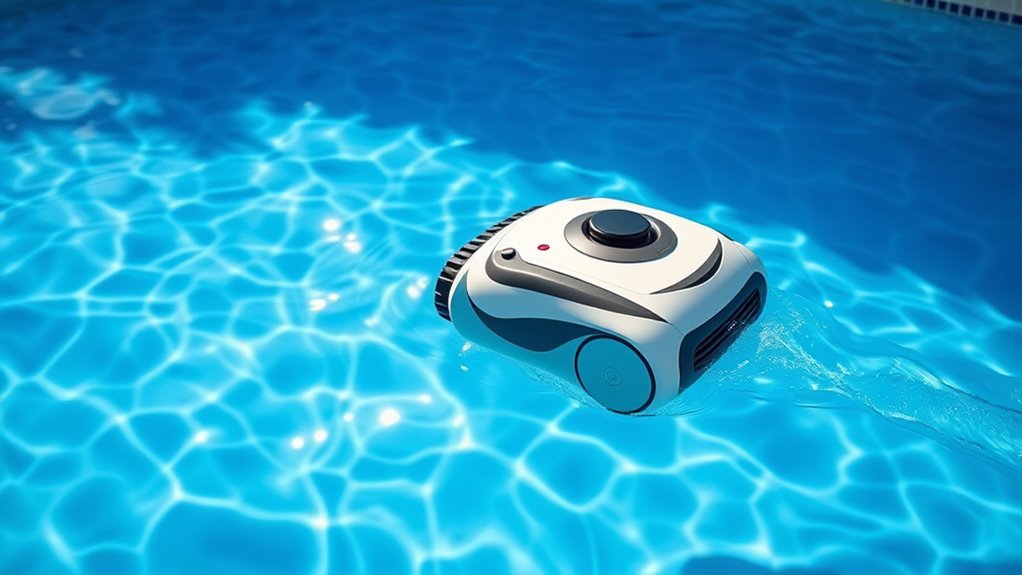
The rise of robotic pool cleaning devices has transformed the way homeowners maintain their pools. These smart devices adapt to different pool sizes and water chemistry, making cleaning more efficient. Here’s how they stand out:
Robotic pool cleaners adapt to pool size and chemistry for more efficient maintenance.
- They automatically map your pool, efficiently covering large or complex shapes without missing spots.
- They adjust their cleaning patterns based on water chemistry, targeting algae-prone areas or debris buildup.
- They monitor water quality and adjust their operation, reducing the need for manual intervention. Many models also incorporate skin-friendly materials that minimize potential irritation or skin sensitivity issues during operation.
- They are often compatible with portable pool accessories like skimmers and chemical dispensers, enhancing overall pool maintenance.
Additionally, advances in sensor technology enable these robots to better detect and respond to various pool conditions, leading to more precise cleaning and water management. Robots are gaining popularity for their ability to handle larger pools and maintain water chemistry balance, saving you time. Unlike traditional cleaners, they work independently and are tailored to your pool’s unique needs, making pool maintenance simpler and more effective. Additionally, the integration of automation technology in these devices ensures seamless operation and monitoring, further optimizing pool care.
Technological Advancements in Pool Cleaning
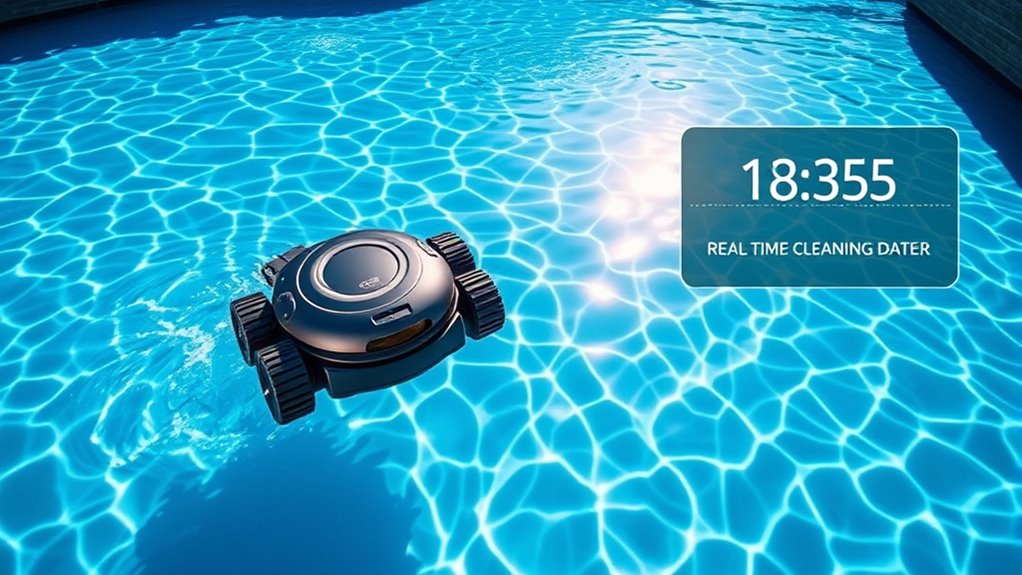
Recent technological advancements have considerably enhanced the efficiency and effectiveness of pool cleaning tools, making maintenance easier for homeowners. Smart technology now powers many devices, enabling them to adapt to pool layouts and debris types seamlessly. These innovations create market disruption, pushing traditional suction cleaners aside. You’ll notice features like automatic scheduling, app control, and sensors that detect dirt and obstacles. The integration of AI and machine learning helps robots optimize cleaning paths, reducing time and energy. Here’s a quick look at the key tech upgrades: Automated navigation systems are now common, further streamlining the cleaning process and reducing manual intervention. Additionally, the incorporation of advanced sensors allows robots to better distinguish between debris types and clean more efficiently. The adoption of machine learning algorithms enables robots to improve their performance over time, adapting to changing pool conditions. Furthermore, these robots can now self-diagnose issues, minimizing downtime and maintenance costs, which is a significant technological advancement in pool care.
Cost Comparison and Value Proposition
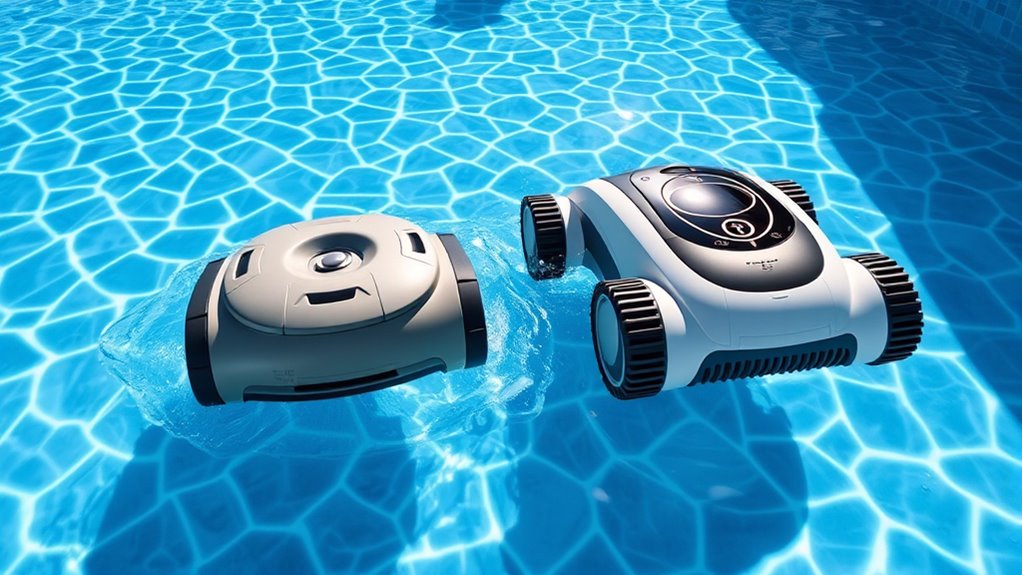
While advanced pool cleaning robots often come with higher upfront costs, many homeowners find they deliver better long-term value by reducing maintenance time and water usage. When comparing costs, consider these factors:
- Pricing strategies – Robots typically have variable prices based on features, while suction cleaners tend to be more consistent and budget-friendly.
- Warranty coverage – Robots often include longer warranties, offering peace of mind and protection against repairs.
- Operational savings – Robots usually require less manual intervention, saving you time and potential repair costs over time. Additionally, their advanced technology can lead to improved cleaning efficiency compared to traditional suction models. As technology advances, these devices are becoming increasingly user-friendly, making them accessible for more homeowners. The integration of smart navigation systems further enhances their ability to clean efficiently with minimal oversight. Incorporating automation into pool maintenance not only streamlines the process but also minimizes human error and enhances overall effectiveness.
- Affiliate partnerships – Many brands leverage affiliate marketing to expand their reach and offer competitive pricing options.
Although the initial investment is higher, the improved efficiency and longer warranty coverage can make robots a smarter, more cost-effective choice in the long run.
Environmental Impact and Energy Efficiency
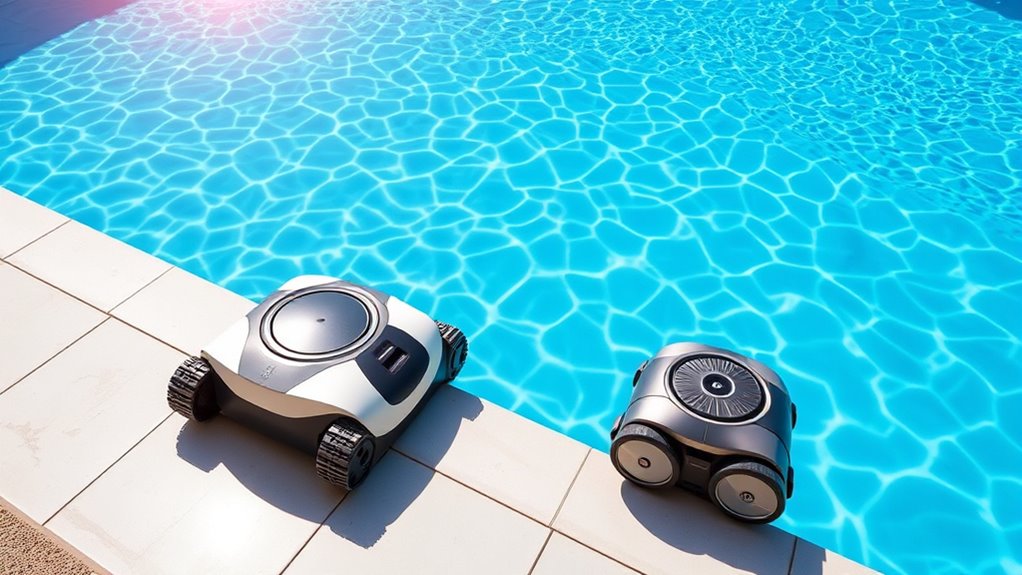
As you consider suction pool cleaners and robots, it’s important to look at their energy consumption and how eco-friendly cleaning methods can reduce environmental impact. These devices often use less power than traditional cleaning options, helping you save energy and cut costs. Additionally, their waste reduction benefits mean fewer chemicals and debris ending up in your pool and the environment. Using advanced paint sprayer tips can further enhance efficiency and minimize waste during application. Moreover, adopting sustainable cleaning practices can help extend the lifespan of your pool equipment and promote eco-conscious maintenance. Incorporating energy-efficient technologies into your cleaning routine can further optimize performance while reducing your carbon footprint.
Energy Consumption Comparison
When comparing suction pool cleaners and robots, energy consumption plays a crucial role in evaluating their environmental impact and efficiency. Suction cleaners often have higher power consumption due to continuous operation, impacting energy savings over time. Robots, on the other hand, typically use less power, thanks to smart navigation and efficient motors. Consider these points:
- Suction cleaners run longer, increasing overall power consumption.
- Robots optimize cleaning cycles, reducing energy use.
- Energy-efficient models in both types help lower environmental impact while saving costs.
- Incorporating sample libraries can inspire innovative designs for quieter, more efficient robotic cleaners.
- Advances in energy efficiency are driving the development of smarter, eco-friendly pool cleaning solutions.
- The integration of sound design principles can lead to quieter operation and improved user experience in robotic pool cleaners.
- Implementing power management features can further reduce energy consumption and extend device lifespan.
- Developing smart sensors can enhance the precision of robotic cleaners, further reducing unnecessary energy expenditure.
Your choice depends on balancing power consumption with cleaning needs. While suction cleaners might consume more energy, robots offer better energy savings through smarter operation. This comparison highlights the importance of considering energy efficiency when evaluating their environmental footprint.
Eco-Friendly Cleaning Methods
Choosing an eco-friendly cleaning method for your pool means considering both environmental impact and energy efficiency. Using biodegradable detergents minimizes harmful chemicals released into the environment, helping protect local ecosystems. These eco-friendly cleaners break down naturally, reducing pollution and aquatic toxicity. Additionally, opting for solar-powered devices offers a sustainable way to operate your pool cleaner without increasing energy consumption. Solar-powered robots or pumps harness sunlight, lowering your carbon footprint and saving on electricity costs. These methods not only promote a greener approach but also enhance energy efficiency in maintaining your pool. Incorporating proper installation and venting techniques can further improve safety and operational efficiency, ensuring your eco-friendly methods are effective and sustainable. Moreover, integrating AI-driven analytics can optimize your pool maintenance schedule, reducing unnecessary energy use and promoting sustainability. By integrating biodegradable detergents and solar-powered devices into your routine, you contribute to a cleaner environment while enjoying effective, eco-conscious pool maintenance.
Waste Reduction Benefits
Have you considered how waste reduction in your pool cleaning routine can benefit both the environment and your energy use? Using more efficient cleaners minimizes chemical runoff, reducing harmful pollutants entering waterways. It also promotes water conservation by decreasing the need for frequent refills and chemical treatments. To maximize these benefits, focus on:
- Choosing eco-friendly cleaners that produce less waste and chemical runoff.
- Regularly maintaining your equipment to prevent leaks and inefficiencies.
- Opting for robotic cleaners that use less energy compared to traditional methods.
These steps help reduce waste, lower your energy consumption, and ensure a cleaner, healthier environment for everyone. Making smarter choices in pool maintenance directly impacts water conservation efforts and minimizes environmental harm.
User Experience and Maintenance Requirements

Suction pool cleaners and robots are designed to make pool maintenance easier, but your experience with them can vary based on their ease of use and upkeep. User satisfaction depends on how smoothly the device operates and how simple it is to set up and control. Robots often offer more user-friendly features, like programmable schedules and app controls, which enhance the experience. However, maintenance complexity can differ; some suction cleaners require frequent manual cleaning of filters and hoses, which can be tedious. Robots typically need regular brush and filter cleaning but tend to be easier to maintain overall. Your comfort with these devices hinges on their reliability, ease of maintenance, and how well they fit into your routine.
Market Adoption and Consumer Preferences

What drives consumers to adopt suction pool cleaners and robots? Primarily, it’s their desire for convenience and efficiency. However, consumer skepticism about new technology and brand loyalty also influence decisions. You might consider these factors:
- Performance Reliability: Consumers prefer trusted brands that consistently deliver clean pools, reducing skepticism.
- Ease of Use: Simple operation encourages adoption, especially when switching from traditional methods.
- Brand Loyalty: Customers often stick with familiar brands, which impacts the choice between suction cleaners and robots.
While robots offer advanced features, skepticism about their durability can hinder widespread adoption. Conversely, established brands with strong reputations retain customer loyalty, making them more resilient in market shifts.
Limitations and Challenges of Robotic Cleaners
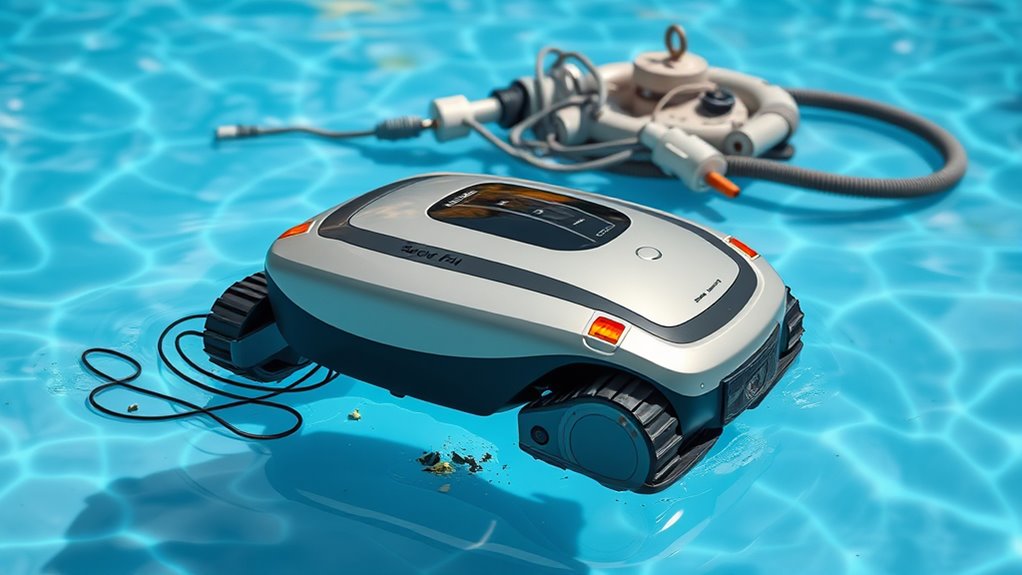
Robotic pool cleaners face challenges like navigation errors and obstacles that can hinder their effectiveness. Limited battery life also means they might not clean your entire pool in one session, requiring multiple charges. Additionally, their higher prices can make them less accessible for some users, restricting widespread adoption.
Navigation and Obstacle Issues
Have you ever wondered how effectively a robotic pool cleaner navigates complex pool environments? Navigation challenges and obstacle detection are significant hurdles. Many robotic cleaners struggle with:
- Recognizing and avoiding obstacles like toys or pool fixtures.
- Maintaining a systematic cleaning pattern without missing spots.
- Handling uneven surfaces or steep slopes safely.
These issues can cause the robot to get stuck or miss areas, reducing cleaning efficiency. Limited sensors hinder obstacle detection, leading to collisions or incomplete coverage. Some models rely on basic boundary detection, but more advanced navigation systems are still developing. As a result, robotic cleaners may require manual assistance or repeated passes for thorough cleaning, especially in cluttered pools. Overcoming navigation issues remains essential for the future effectiveness of robotic pool cleaners.
Battery Life Constraints
Battery life remains a significant limitation for robotic pool cleaners, often restricting their cleaning sessions to just a few hours. This short battery longevity means you need to plan multiple cycles or manually intervene to complete the job. The recharge duration can also be lengthy, sometimes taking several hours before the robot is ready for another round. This downtime hampers efficiency, especially for larger pools requiring extensive coverage. Limited battery capacity forces you to monitor cleaning progress closely, and it can prevent continuous operation during a single session. As technology advances, manufacturers are working on improving battery efficiency and reducing recharge duration, but current models still face these constraints. Ultimately, battery life remains a critical factor influencing the effectiveness and practicality of robotic pool cleaners.
Pricing and Accessibility
Affordable robotic pool cleaners remain scarce, making them a significant investment for many homeowners. This challenge stems from pricing strategies that keep advanced models out of reach for average consumers. Market accessibility is limited by high costs, complex features, and limited distribution channels. To improve this, manufacturers could:
- Offer tiered pricing to cater to different budgets.
- Expand distribution to reach more markets.
- Simplify features to lower production costs and boost affordability.
These steps could make robotic cleaners more accessible, encouraging wider adoption. Currently, high prices restrict many users from benefiting from the convenience and efficiency these devices offer. As a result, suction pool cleaners remain a more common choice for budget-conscious homeowners, despite the technological advantages of robotic alternatives.
Future Innovations in Pool Cleaning Technology
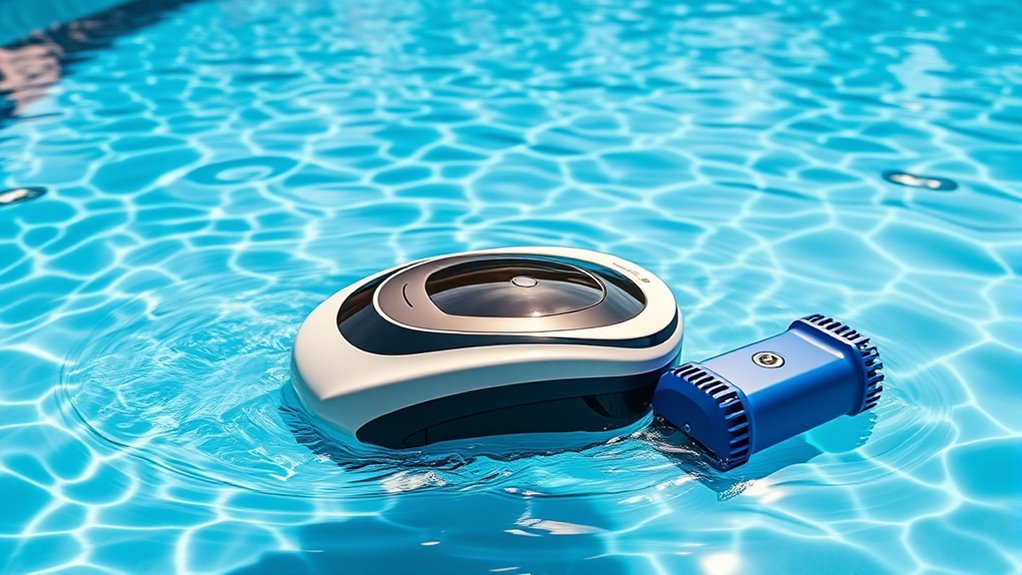
As technology continues to advance, future innovations in pool cleaning are poised to make maintenance more efficient and effortless. Expect smart water sensors to play a central role, constantly monitoring water quality and automatically adjusting cleaning routines for finest results. These sensors will enable your cleaner to detect debris, chemical levels, and water temperature, ensuring precise cleaning without waste. Additionally, biodegradable cleaning agents will become standard, helping you maintain a sparkling pool while minimizing environmental impact. Future devices may also incorporate AI-driven navigation, allowing robots to learn your pool’s unique layout and optimize cleaning paths. These innovations will reduce your effort, save you money, and promote a healthier environment, transforming pool maintenance into a seamless, eco-friendly experience.
Strategic Implications for Industry Stakeholders
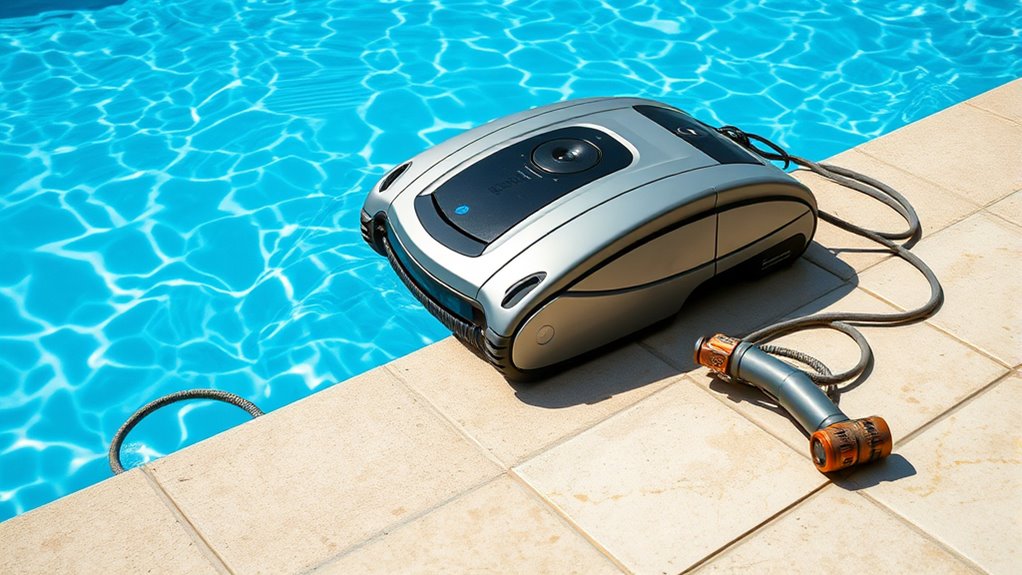
Emerging innovations in pool cleaning technology will substantially impact industry stakeholders by increasing competition, reshaping market dynamics, and prompting strategic adaptations. To stay ahead, you should focus on refining your market entry strategies to leverage new robotic solutions effectively. Consider these key actions:
Innovate and partner strategically to stay competitive amid emerging pool cleaning technologies.
- Innovate product offerings to differentiate your brand and meet evolving customer preferences.
- Strengthen competitive positioning by investing in advanced technology and customer service.
- Form strategic partnerships with tech developers to gain early access to innovations and expand market reach.
Frequently Asked Questions
How Do Robotic Pool Cleaners Impact Traditional Pool Maintenance Routines?
Robotic pool cleaners substantially change your pool maintenance and cleaning schedules. They automate the cleaning process, reducing the time and effort you spend on manual tasks. With robots handling debris and dirt efficiently, you can stick to less frequent cleaning routines while maintaining a sparkling pool. This shift allows for more consistent pool care, freeing up your time and ensuring your pool stays cleaner with minimal effort.
What Are the Long-Term Cost Benefits of Robotic Versus Suction Pool Cleaners?
Think of your pool’s cleaning as a marathon, not a sprint. Robot cleaners often offer better energy savings, reducing your power bills over time. They also cut maintenance costs by being more efficient and requiring less manual intervention. While the upfront investment may be higher, long-term, you save money and enjoy a cleaner pool with less hassle, making robotic cleaners a smart, enduring choice for your pool’s health and your wallet.
Are Robotic Cleaners Suitable for All Pool Types and Sizes?
Robotic cleaners work well for many pool types, but their suitability depends on your pool shape and water chemistry. If you have a complex shape or irregular corners, a robotic cleaner can navigate better than suction models. However, for pools with delicate water chemistry or specific filtration needs, you should verify the robot’s features match your pool’s requirements. Always check compatibility before making a choice.
How Do Consumer Preferences Influence the Market Share of Robotic Cleaners?
Consumer preferences greatly influence the market share of robotic cleaners. You tend to trust brands with proven reliability and high consumer trust, which boosts brand loyalty. As more customers prefer advanced, user-friendly features, manufacturers innovate to meet these demands. If you’re satisfied with a brand, you’re more likely to stick with it, giving that company a competitive edge. Your preferences shape the market, encouraging brands to prioritize quality and customer satisfaction.
What Are Upcoming Technological Innovations in Robotic Pool Cleaning?
Imagine a robotic pool cleaner gliding effortlessly across your pool, guided by AI integration and advanced navigation. Soon, you’ll see smarter designs that adapt to debris patterns, optimize cleaning paths, and even detect water quality issues in real time. These technological innovations promise a new era of efficiency, making manual cleaning a thing of the past. Get ready for robots that not only clean but anticipate your pool’s needs seamlessly.
Conclusion
So, are suction pool cleaners doomed? Not quite. While robots glide in with fancy tech and eco-cred, you’ll still find loyal users sticking to the simple, cheap suction models. It’s a bit like expecting a robot butler at your door—nice in theory, but for now, your trusty old cleaner still gets the job done. Until robots perfect their poolside charm, you might as well enjoy the best of both worlds—and keep the pool sparkling.
